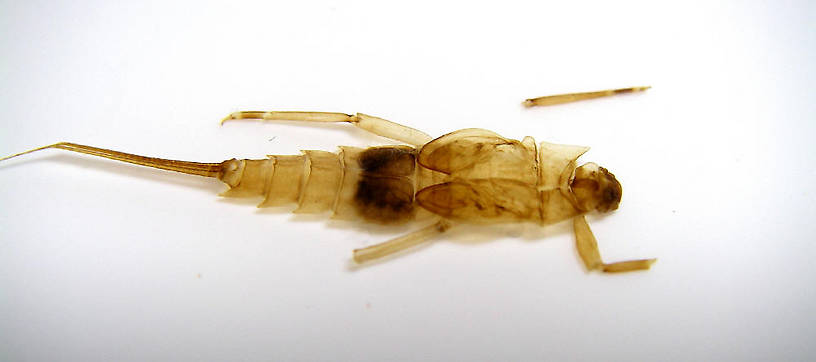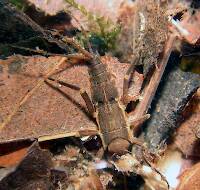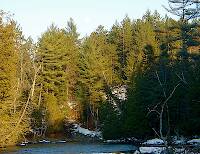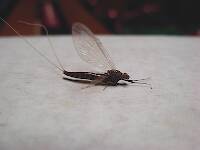
Blue-winged Olives
Baetis
Tiny Baetis mayflies are perhaps the most commonly encountered and imitated by anglers on all American trout streams due to their great abundance, widespread distribution, and trout-friendly emergence habits.
Featured on the forum

This species was fairly abundant in a February sample of the upper Yakima.

Troutnut is a project started in 2003 by salmonid ecologist Jason "Troutnut" Neuswanger to help anglers and
fly tyers unabashedly embrace the entomological side of the sport. Learn more about Troutnut or
support the project for an enhanced experience here.

This specimen was sent to me for identification by Caleb Boyle, who did such a good job taking pictures of his mystery mayfly that, after identification, I asked him for permission to add it to this site, which he granted. This is great luck, since Neoephemera is a rare mayfly and it's unlikely I would ever have collected a specimen for the site myself.
Caleb collected it in mid-late May of 2004 either McDowell County or Ashe County in North Carolina, in a riffle less than two feet deep in a cold trout stream. He reared the nymph into a dun, whose wings appear in one of the photos below. He describes the specimen as follows:
Nymph exoskeleton:
Body: 16-17mm
Tails: 3, equal length, 13mm
Found on the surface of the water. The gill cover covers ab. segments 3-5.
Subimago:
Body: 16mm, dark brown/ olive
Tails: 3, equal length, 14mm
Wings: dark slate color, large hind wings.
I don't know to which species it belongs, but its size rules out the most common one in the genus, Neoephemera bicolor. It matches the size of Neoephemera purporea so that is a likely other possibility, but there are two other candidate species (Neoephemera compressa and Neoephemera youngi) about which I have no information, so I can't rule them out.
Disregard the camera, region, and exact date listed on these photos. I still need to update the site to accommodate user contributions which don't use my equipment.
Caleb collected it in mid-late May of 2004 either McDowell County or Ashe County in North Carolina, in a riffle less than two feet deep in a cold trout stream. He reared the nymph into a dun, whose wings appear in one of the photos below. He describes the specimen as follows:
Nymph exoskeleton:
Body: 16-17mm
Tails: 3, equal length, 13mm
Found on the surface of the water. The gill cover covers ab. segments 3-5.
Subimago:
Body: 16mm, dark brown/ olive
Tails: 3, equal length, 14mm
Wings: dark slate color, large hind wings.
I don't know to which species it belongs, but its size rules out the most common one in the genus, Neoephemera bicolor. It matches the size of Neoephemera purporea so that is a likely other possibility, but there are two other candidate species (Neoephemera compressa and Neoephemera youngi) about which I have no information, so I can't rule them out.
Disregard the camera, region, and exact date listed on these photos. I still need to update the site to accommodate user contributions which don't use my equipment.
Troutnut on Mar 20, 2007March 20th, 2007, 1:09 pm EDT
Caleb Boyle sent me this specimen to identify and, when I realized it was of a genus I'm unlikely to ever collect, I asked if I could put it up on the site. Read the specimen description for more info.
This is the first specimen by another photographer that I've included on Troutnut.com. Several excellent photographers have expressed interest in contributing, and I hope to start getting their pictures up this year in addition to mine. Before I start doing that on a large scale, I have a few days worth of programming I'll need to do to prepare the site. In the meantime, enjoy this one. :)
This is the first specimen by another photographer that I've included on Troutnut.com. Several excellent photographers have expressed interest in contributing, and I hope to start getting their pictures up this year in addition to mine. Before I start doing that on a large scale, I have a few days worth of programming I'll need to do to prepare the site. In the meantime, enjoy this one. :)
Jason Neuswanger, Ph.D.
Troutnut and salmonid ecologist
Troutnut and salmonid ecologist
Taxon on Mar 20, 2007March 20th, 2007, 7:54 pm EDT
Caleb-
There are confirmed records of Neoephemera youngi in Cleveland County, the NE corner of which is only about 7.5 miles from the SE corner of Mcdowell County. However, this species was recognized in 1953, long after The Biology Of Mayflies was published in 1931, so I don’t have access to a measurement for the adult body length or to any other descriptive information concerning it.
Neoephemera purpurea, which was classified as Oreianthus purpureus at the time The Biology Of Mayflies was written, is the only other Neoephemera species believed to reside in North Carolina, but I don’t have access to its counties of residence. However, its adult body length (16 mm for the female) is exactly the same as you report your specimen to be, although I don’t know whether your specimen was a female, as only a photo of the dun’s wings was posted.
So, the bottom line is, your specimen would be either Neoephemera youngi or N. purpurea, but I simply have inadequate information to suggest which it is more likely to be.
There are confirmed records of Neoephemera youngi in Cleveland County, the NE corner of which is only about 7.5 miles from the SE corner of Mcdowell County. However, this species was recognized in 1953, long after The Biology Of Mayflies was published in 1931, so I don’t have access to a measurement for the adult body length or to any other descriptive information concerning it.
Neoephemera purpurea, which was classified as Oreianthus purpureus at the time The Biology Of Mayflies was written, is the only other Neoephemera species believed to reside in North Carolina, but I don’t have access to its counties of residence. However, its adult body length (16 mm for the female) is exactly the same as you report your specimen to be, although I don’t know whether your specimen was a female, as only a photo of the dun’s wings was posted.
So, the bottom line is, your specimen would be either Neoephemera youngi or N. purpurea, but I simply have inadequate information to suggest which it is more likely to be.
Troutnut on Mar 21, 2007March 21st, 2007, 1:10 am EDT
Neoephemera compressa is known only from a few of the northernmost counties in Florida. While it may not be reported from North Carolina, I wouldn't use those distribution records to completely rule it out, either. My collecting has led me to take the USGS distribution pages with a grain of salt, at least when it comes to judging the absence of things from one area when they do occur in the same general region. This is especially true of mayflies which aren't very prolific where they do occur.
So I still think it could be any of the three, although it probably is more likely to be one of the two species reported from the state.
So I still think it could be any of the three, although it probably is more likely to be one of the two species reported from the state.
Jason Neuswanger, Ph.D.
Troutnut and salmonid ecologist
Troutnut and salmonid ecologist
Quick Reply
Related Discussions
Topic
Replies
Last Reply
3
Sep 14, 2010
by Jmd123
by Jmd123
1
Feb 10, 2010
by Oldredbarn
by Oldredbarn
2
Mar 20, 2007
by Taxon
by Taxon
13
Jul 25, 2014
by Millcreek
by Millcreek
43
Sep 7, 2016
by Jmd123
by Jmd123
3
Dec 22, 2007
by Creno
by Creno






